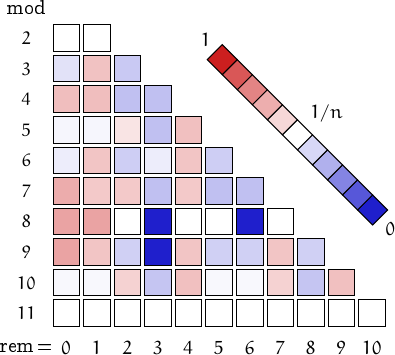The tribonacci numbers up to 1015 :
1, 2, 4, 7, 13, 24, 44, 81, 149, 274, 504, 927, 1705, 3136, 5768, 10609, 19513, 35890, 66012, 121415, 223317, 410744, 755476, 1389537, 2555757, 4700770, 8646064, 15902591, 29249425, 53798080, 98950096, 181997601, 334745777, 615693474, 1132436852, 2082876103, 3831006429, 7046319384, 12960201916, 23837527729, 43844049029, 80641778674, 148323355432, 272809183135, 501774317241, 922906855808, 1697490356184, 3122171529233, 5742568741225, 10562230626642, 19426970897100, 35731770264967, 65720971788709, 120879712950776, 222332455004452, 408933139743937, 752145307699165.
Distribution of the remainders when the numbers in this family are divided by n=2, 3,..., 11. (I took into account 100000 values, from 1 to 2.96⋅1026464).
| n\r | 0 | 1 | |||||||||
|---|---|---|---|---|---|---|---|---|---|---|---|
| 2 | 50000 | 50000 | 2 | ||||||||
| 3 | 30768 | 46155 | 23077 | 3 | |||||||
| 4 | 37500 | 37500 | 12500 | 12500 | 4 | ||||||
| 5 | 19353 | 19355 | 22581 | 9678 | 29033 | 5 | |||||
| 6 | 15384 | 23078 | 11539 | 15384 | 23077 | 11538 | 6 | ||||
| 7 | 25000 | 18750 | 18750 | 6251 | 18750 | 6249 | 6250 | 7 | |||
| 8 | 25000 | 25000 | 12500 | 0 | 12500 | 12500 | 0 | 12500 | 8 | ||
| 9 | 23076 | 15386 | 7693 | 0 | 15385 | 7692 | 7692 | 15384 | 7692 | 9 | |
| 10 | 9676 | 9678 | 11290 | 4840 | 14519 | 9677 | 9677 | 11291 | 4838 | 14514 | 10 |
| 11 | 9091 | 9092 | 9093 | 9090 | 9092 | 9090 | 9091 | 9091 | 9090 | 9090 | 9090 |
A pictorial representation of the table above

Imagine to divide the members of this family by a number n and compute the remainders. Should they be uniformly distributed, each remainder from 0 to n-1 would be obtained in about (1/n)-th of the cases. This outcome is represented by a white square. Reddish (resp. bluish) squares represent remainders which appear more (resp. less) frequently than 1/n.
e-mail: info -at- numbersaplenty.com • Privacy notice • engine limits